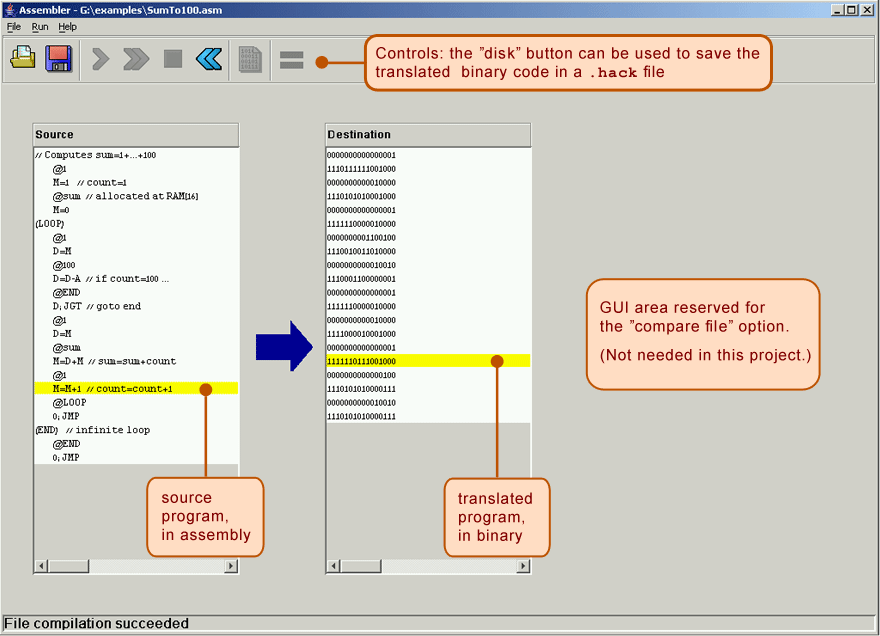
The Elements of Computing
Systems / Nisan & Schocken / www.idc.ac.il/tecs
Project 4: Machine
Level Programming
Objective:
To get a taste of low-level programming
in machine language, and to get acquainted with the Hack computer platform. In
the process of working on this project, you will also become familiar with the
assembly process, and you will appreciate visually how the translated binary
code executes on the target hardware.
Resources:
In this project you will use two tools supplied with the book: an assembler,
designed to translate Hack assembly programs into binary code, and a CPU
Emulator,
designed to run binary programs on a simulated Hack platform.
Contract:
Write and test the two programs described below. When executed on the CPU
Emulator, your programs should generate the results mandated by the test scripts
supplied in the project directory.
| Program | Function | Comments |
|
Mult.asm |
Multiplication: The inputs of this program are the current values stored in R0 and R1 (i.e. the two top RAM locations). The program computes the product R0*R1 and stores the result in R2. |
We
assume (in this program) that R0>=
0, R1>=
0, and R0*R1<32768.
Your program need not test these conditions, but rather
assume that they
hold. The supplied Mult.tst
and Mult.cmp
scripts will test your program on several representative data values. |
|
Fill.asm |
I/O handling: This program runs an infinite loop that listens to the keyboard input. When a key is pressed (any key), the program blackens the screen, i.e. writes "black" in every pixel. When no key is pressed, the screen should be cleared. |
You may choose to blacken and clear the screen in any visual order, as long as pressing a key continuously for long enough will result in a fully blackened screen and not pressing any key for long enough will result in a cleared screen. This program has a test script (Fill.tst) but no compare file – it should be checked visually by inspecting the simulated screen. |
Steps
We recommend proceeding in the following order:
0.
The assembler and CPU Emulator programs needed for this
project are available in the tools directory of the book’s software
suite. Before using them, go through the Assembler Tutorial and the CPU
Emulator Tutorial, available in the tutorials
directory.
1. Create a directory named projects/04 con your computer and extract project 04.zip to it (preserving the directory structure embedded in the zip file).
2.
Use a plain text editor to write the first program in assembly, and save it as projects/04/mult/Mult.asm.
3.
Use the supplied assembler
(in either batch or interactive mode) to translate your program. If you get
syntax errors, go to step 1. If there are no syntax errors, the assembler will
produce a file called projects/04/mult/Mult.hack,
containing binary machine instructions.
4. Use the supplied CPU Emulator to test the resulting Mult.hack code. This can be done either interactively, or batch-style using the supplied Mult.tst script. If you get run-time errors, go to step 1.
5.
Repeat stages 2-4 for the second program (Fill.asm),
using the projects/04/fill
directory.
Debugging Tip: The Hack language is case sensitive. A common error occurs when one writes, say, “@foo” and “@Foo” in different parts of the program, thinking that both commands refer to the same variable. In fact, the assembler treats these symbols as two completely different identifiers.
Tools
The supplied assembler: The book’s software suite includes a Hack assembler that can be used in either command mode or GUI mode. The latter mode of operation allows observing the translation process in a visual and step-wise fashion.

The
machine language programs produced by the assembler can be tested in two
different ways. First, one can run the .hack
program in the CPU Emulator. Alternatively, one can run the same program
directly on the hardware, by loading it into the computer’s instruction memory
using the hardware simulator. Since we will complete building the hardware
platform only in the next chapter, the former option makes more sense at this
stage.
The
supplied CPU Emulator: This program
simulates the Hack computer platform. It allows loading a Hack program into the
simulated ROM, and visually observing its execution on the simulated hardware.

For
ease of use, the CPU Emulator enables loading binary .hack
files as well as symbolic .asm
files. In the latter case, the emulator translates the assembly program into
binary code on the fly. This utility seems to render the supplied assembler
unnecessary, but this is not the case. First, the supplied assembler shows the
translation process visually, for instructive purposes. Second, the binary files
generated by the assembler can be executed directly on the hardware
platform.
To do so, load the Computer
chip (built in Project 5) into the hardware simulator, and then load the .hack
file generated by the assembler into the computer’s ROM chip.